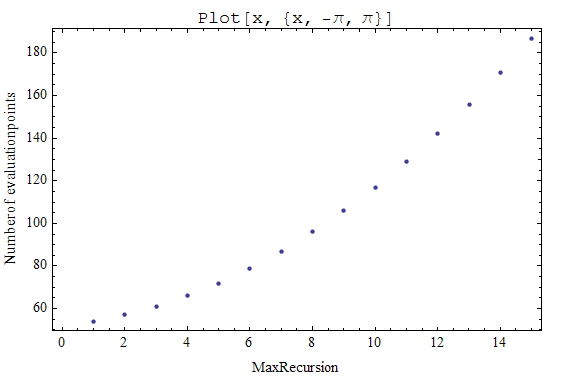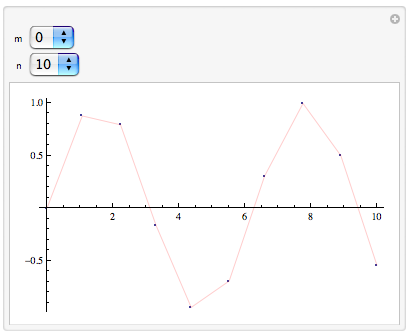It is interesting to compare the Plot algorithms of Mathematica 5.2 and Mathematica 6+. Based on acl's code:
In Mathematica 5.2 we get:
Plot[Sow[x]; Sin[x], {x, 0, 10},
DisplayFunction -> (Null &)] // Reap // Last // Last // ListPlot

In Mathematica 7.0.1:
Plot[Sow[x]; Sin[x], {x, 0, 10}] // Reap // Last // Last // ListPlot

One can see that Mathematica 5.2 computes only 105 points while version 7.0.1 computes 567 points (including one symbolic evaluation). At the same time, the plots produced by two versions are visually indistinguishable. Only very careful comparison reveals tiny differences. Here is ListPlot of both sets of points: generated by version 5.2 (dashed black line) and version 7.0.1 (blue line) with resolution 600 dpi (click to enlarge!):

Edit
In Mathematica 5.2 the default value for PlotPoints is 25 and for PlotDivision is 30 as documented in Section 1.9.2 of "The Mathematica Book" for version 5.2. I do not know where the default value for PlotPoints in version 7 is documented but we can find it by setting MaxRecursion to zero:
In[1]:= Cases[Plot[x, {x, 0, 10}, MaxRecursion -> 0],
Line[x_] :> Length[x], Infinity]
Out[1]= {50}
From the other side, using Reap and Sow we get different value:
In[2]:= Select[
Plot[Sow[x], {x, 0, 10}, MaxRecursion -> 0]; // Reap //
Last // First, NumericQ] // Length
Out[2]= 51
For Mathematica 5.2 both methods give the same result (25). It seems that in Mathematica 7.0.1 the first point is calculated just for the check that the objective function gives numerical value for numerical argument but this point is not included in the final plot:
In[4]:= Complement[
Plot[Sow[x], {x, 0, 10}, MaxRecursion -> 0, PlotPoints -> 25] //
Reap // Last // First,
Cases[Plot[x, {x, 0, 10}, MaxRecursion -> 0, PlotPoints -> 25],
Line[x_] :> x, Infinity][[1, All, 1]]]
Out[4]= {0.000417083, x}
Edit 2
In Mathematica 7 increasing MaxRecursion just adds new layers of points to the ListPlot:
v7points[r_] :=
Module[{i = 1},
Last@Last@
Reap@Plot[Sow[{i++, x}]; Sin[x], {x, 0, 10}, PlotPoints -> 25,
MaxRecursion -> r]];
v7plot = ListPlot[Join[{v7points[0]},
Complement[v7points[# + 1], v7points[#]] & /@ Range[0, 10]],
PlotMarkers -> (Graphics`PlotMarkers[] /. {m_, s_} :> {m, s/2}),
PlotStyle -> ColorData[60, "ColorList"]]]]

In Mathematica 5.2 we have PlotDivision instead of MaxRecursion:
v5Points[d_] :=
krn5Eval[Module[{i = 1},
Last@Last@
Reap@Plot[Sow[{i++, x}]; Sin[x], {x, 0, 10}, PlotPoints -> 25,
PlotDivision -> d, DisplayFunction -> (Null &)]]]
v5plot = ListPlot[v5Points[#] & /@ Range[1, 9],
PlotMarkers -> (Graphics`PlotMarkers[] /. {m_, s_} :> {m, s/2}),
PlotStyle -> ColorData[60, "ColorList"]]
(here krn5Eval[expr] is a MathLink function which evaluates expr in the kernel of Mathematica 5 from inside of Mathematica 7)

From the point of view of the number of evaluations in the case of plotting of Sin[x] PlotPoints -> 2, PlotDivision -> 30 is roughly equivalent to PlotPoints -> 2, MaxRecursion -> 5. So we can compare:
v7Ps = Last@
Last@Reap@
Plot[Sow[{x, Sin[x]}]; Sin[x], {x, 0, 10}, PlotPoints -> 2,
MaxRecursion -> 5];
v5Ps = Last@
Last@krn5Eval[
Reap@Plot[Sow[{x, Sin[x]}]; Sin[x], {x, 0, 10}, PlotPoints -> 2,
DisplayFunction -> (Null &), PlotDivision -> 30]];
ListLinePlot[Sort /@ {v7Ps, v5Ps},
PlotStyle -> {Blue, {Black, Dashed}}]
 (click to enlarge!)
(click to enlarge!)
Edit 3
Both algorithms have the same drawback: adaptive refinement is made by minimizing the angles at the nodes connecting the segments of the approximating polyline, but if a corner was once close enough to 180 degrees (180 degrees minus this angle is less than the corresponding parameter: MaxBend or ControlValue), the corresponding node is dropped and no longer checked. Here is an illustration of what happens in version 5.2:

The same case for Mathematica 6+ was already investigated by Yaroslav Bulatov: "Strange Sin[x] graph in Mathematica."
In such cases increasing of MaxRecursion in MMa 6+ does nothing since the node is already dropped from the list of nodes to check. In Mathematica 5 the problem is more subtle: changing any of the control parameters (PlotPoints, MaxBend, PlotDivision) shifts all sample points and as a result the problematic node disappear but now it may emerge in another place. And increasing PlotDivision will not reduce the probability to face this problem again if you have already faced it. The only reliable solution is to considerably increase PlotPoints.
Edit 4
The MaxBend option of Plot in Mathematica 5 has a completely equivalent undocumented sub-sub-option ControlValue in Mathematica 6+ with only difference: the latter should be specified in radians while the former in degrees. At the same time, Mathematica 6+ still has the old MaxBend option moved inside of Method option. I have found it accidentally by evaluating
Plot[x,{x,0,1},MaxBend->1,PlotDivision->1];
MaxBend::deprec: MaxBend->1 is deprecated and will not be supported in future versions of Mathematica. Use Method->{MaxBend->1} instead.
PlotDivision::deprec: PlotDivision->1 is deprecated and will not be supported in future versions of Mathematica. Use Method->{PlotDivision->1} instead. >>
I have tested it and found that the following two ways to specify MaxBend are completely equivalent in Mathematica 7.0.1 and 8.0.4:
In[1]:= With[{maxBend = 5},
First@Plot[Sin[x], {x, -42 Pi, 42 Pi},
PlotRange -> {{-110, -90}, All}, Method -> {MaxBend -> maxBend}] ===
First@Plot[Sin[x], {x, -42 Pi, 42 Pi},
PlotRange -> {{-110, -90}, All},
Method -> {"Refinement" -> {"ControlValue" -> maxBend*\[Degree]}}]]
Out[1]= True
When these options are specified together the ControlValue is used.
Note that MaxBend in version 5 by has default value 10. (degrees) while in version 6+ it has default value 5*Degree (radians). The less this value - the more precise plot will be generated, so in really it is not correct to compare these algorithms with no attention to this option.
One important feature (bug?) of Plot in Mathematica 6+ is that it does not stop adding new levels of recursion when the "ControlValue" condition is already satisfied:
l[mr_] :=
Length@Reap[Plot[Sow[x], {x, -Pi, Pi}, MaxRecursion -> mr]][[2, 1]]
ListPlot[l /@ Range[1, 15], Axes -> False, Frame -> True,
FrameLabel -> {"MaxRecursion", "Number of evaluation points "},
PlotLabel -> StandardForm@HoldForm[Plot[x, {x, -Pi, Pi}]]]

At the same time, in Mathematica 5 Plot stops recursion when bend angles become less than MaxBend:

The danger of PlotRange -> Automatic
With PlotRange -> Automatic edge points where the clipping takes place come not from evaluation of the objective function but from linear interpolation of the actual evaluation points (not all of which are included in the final plot):
f[x_Real] := (Sow[{x, 1/x}] // Last);
r = Reap[Plot[f[x], {x, -1, 1}]];
cpt = Complement[Flatten[Cases[r[[1]], Line[x_] :> x, Infinity], 1], r[[2, 1]]]
{{-0.08742340731847899`, -11.441210582842762`},
{-0.0003010859168438364`, -11.441210582842762`},
{-0.0002994911120048032`, 11.37677150741012`},
{0.08796546946877723`, 11.37677150741012`}}
Interpolation[r[[2, 1]], InterpolationOrder -> 1][cpt[[{1, -1}, 1]]]
{-11.441210582842762`, 11.37677150741012`}












